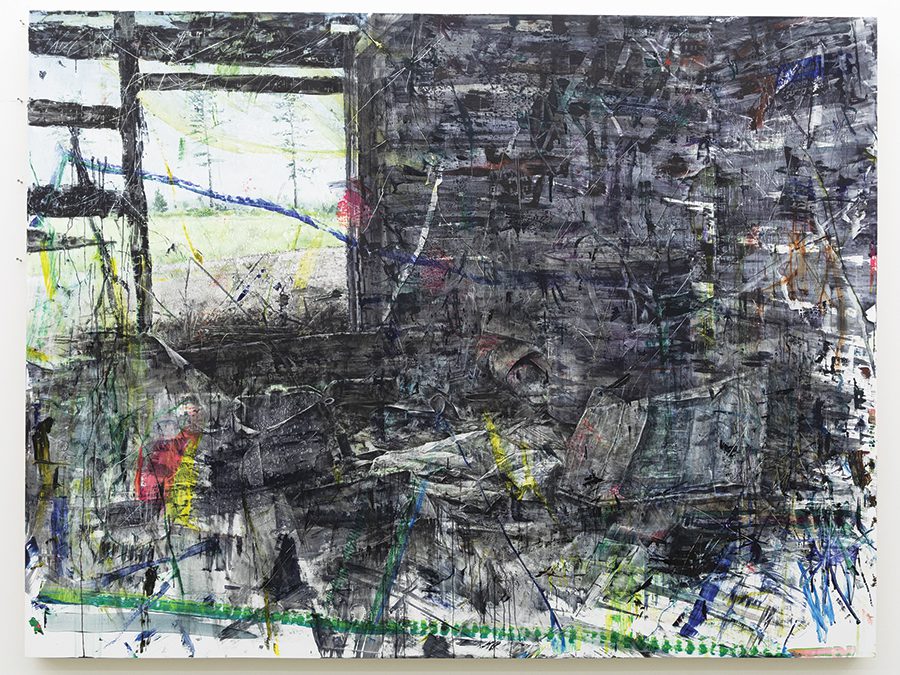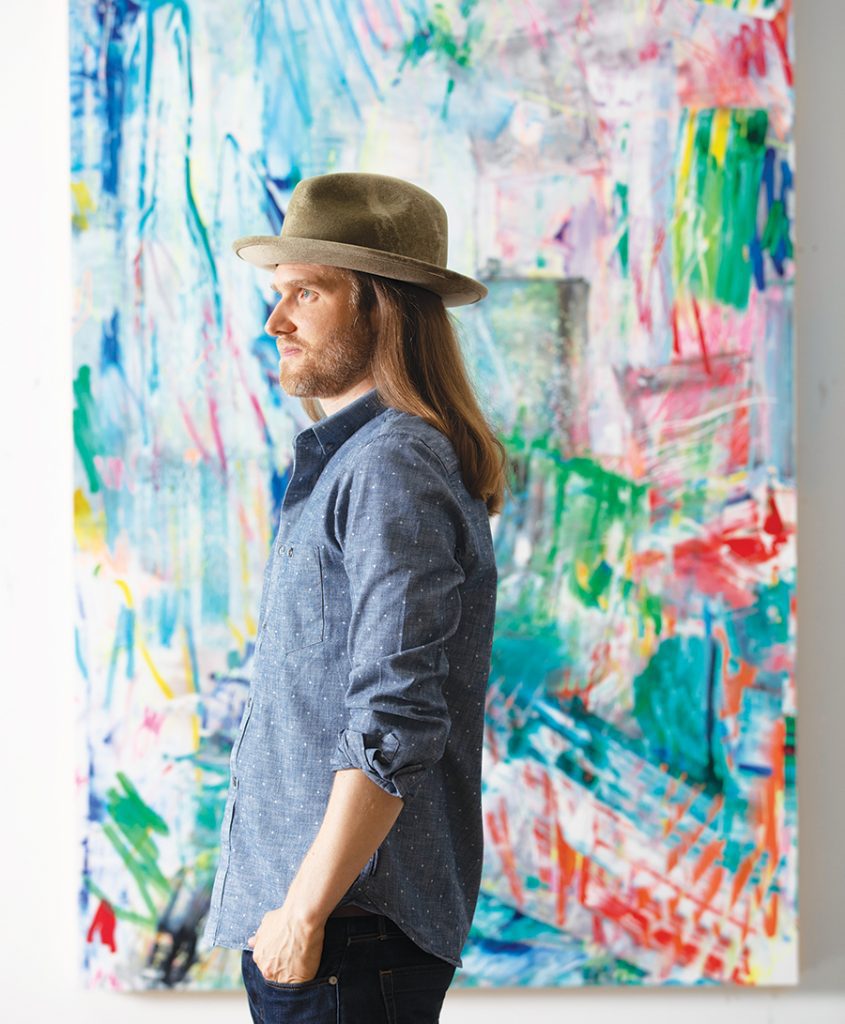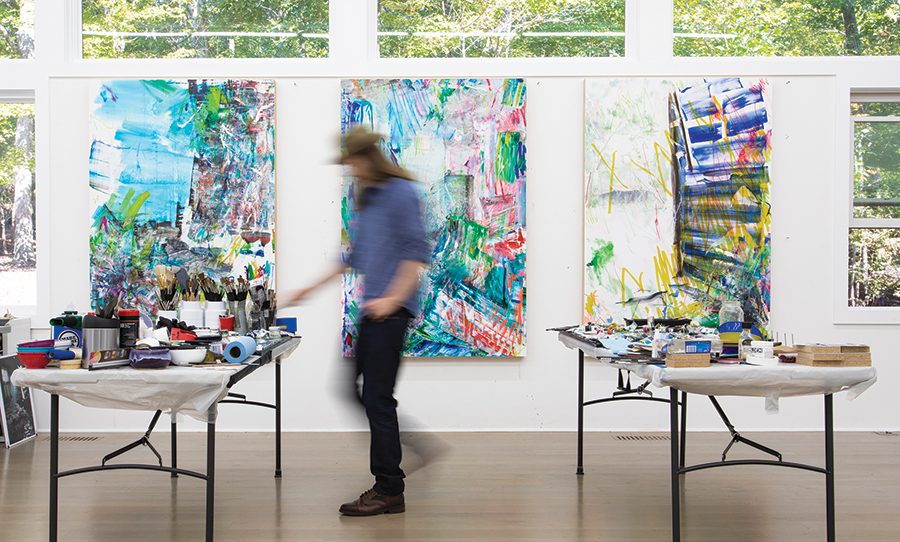The beauty of change
November 1, 2021

Painter Damian Stamer finds inspiration in forgotten spaces. His new exhibition opens this month at SOCO Gallery.
by Courtney Napier • photographs by Taylor McDonald
Damian Stamer was born and raised in northern Durham County, right near a century-old Italianate-style brick building that once contained a prison camp, then a sanitorium for tuberculosis patients, and finally a local television station. Now on the National Historic Registry, this complicated structure is just the sort of thing that bemuses Stamer — and led him to explore its meaning through his paintings.
Stamer was introduced to the world of art in the 1990s as a student at Durham’s Riverside High School. Artist Helen Griffin, Riverside’s art teacher, taught with a contagious passion that transferred to Stamer. “It’s the first time I ever wanted to stay after school to work on projects,” he says. “The piece that I really remember impacting me was the famous Robert Rauschenberg piece with the JFK lithograph. A notion of realist ‘popular’ photographic imagery with his beautiful abstract marks was, to me, a poetic combination. I think I’ve been interested in that dynamic between abstraction and realism and combining them ever since.”
Even as a teenager, he showed potential for being an artist professionally, according to his former teacher. “Early on, Damian understood the work commitment and risk taking required in art making,” Griffin says. “Some people do the bare minimum, but the minimum was never an option for him.”
After graduating from the UNC School of the Arts high-school program in Winston-Salem in 2001, art became both a form of self-expression and a form of self-exploration for Stamer. He traveled to Germany for a study abroad program at the Stuttgart State Academy of Art and Design, then went on to study fine art in Arizona and Hungary before moving to New York City, where he split his time with North Carolina, working toward a master’s in fine arts at UNC Chapel Hill, before settling back here in 2018.
It was in New York City, among the frenetic yet isolating energy of the city, that Stamer began to reflect deeply on his roots. “Coming home for the holidays, I started taking pictures of the weathered buildings around town,” he says. The distance allowed him to see his home with more appreciative and curious eyes. He began to imagine the stories within the walls and beneath the vines of decaying structures. When he returned to the city, he began painting pictures of the scenes he captured. This study of the magic of time upon environments and buildings became a common thread through Stamer’s work.
“Damian’s ability as a painter is profound in multiple ways,” says Jen Sudul Edwards, chief curator and curator of contemporary art at The Mint Museum. “His skill with paint and his confounding treatment of the surface brings a complexity and curiosity to the works, and his haunting subject matter — these abandoned spaces, hovels where nature assumes and consumes spaces once attended to by humans — compounds that disruption, all the while luring you in deeper because they are such stunningly beautiful, complicated compositions.”
In a 2016 profile on PBS NC’s“My Home, NC,” Stamer shares pieces from his Altered Land exhibition, a collection heavily influenced by his memories of the green and aging spaces in and around Hillsborough, near where he grew up. There’s a scene in which he and his twin brother, Dylan, drive to a nearby barn, which resembles a towering triangular bush with the overgrowth of vines that have swallowed the structure. “What’s so exciting about this place,” Stamer muses to his brother, “is that there is a whole unknown world inside. It’s like a treasure chest or a time capsule.”
Stamer’s latest exhibition, and then it wasn’t, which will open at SOCO Gallery this month, is also a time capsule of sorts. Created over the course of the last year — against a background of the Covid-19 pandemic, the Movement for Black Lives following the murder of George Floyd and the pregnancy of his wife with their first child — the collection explores the destructive and transformative nature of time.
“The big changes that happened in 2020 made me reflect on the Buddhist principle of impermanence and equanimity in change,” Stamer says. “There’s a fear of change, but there’s also a beauty and potentiality in it.” He explored the idea that sometimes the dismantling or degrading of old structures and realities can be good — even if it’s challenging and uncomfortable.
“There’s a fear of change, but there’s also a beauty and potentiality in it.”
“While I love his work for all of these art historical reasons, it has a particular poignancy in the South, where history remains present, a site to reckon and reconcile,” Sudul Edwards says. “Even if we didn’t build the original structure, it is ours to tend.”
Stamer’s studio, which he completed in 2016, is connected to the home where he grew up, nestled in lush woodlands. Here, soaring windows along the north-facing wall erase any sense of containment and frame the tall oaks outside. The other three walls are filled with his pictures on hanging canvases, windows into his artistic world. Near the entrance, the door to a storage room is a collage of postcards and small prints by artists who inspired him, including Robert Rauschenberg, Jean-Michel Basquiat, Neo Rauch and Cy Twombly.
For and then it wasn’t, Stamer pushed himself to a new level of vulnerability through more abstract expression than ever before, offering paintings that are markedly more vibrant and nonrepresentational than his former works. “Horry County 25,” which Stamer started in 2018 and finished last year, shows what appears to be a darkly painted interior room in the center of the panel. Then, in a visceral shift, Stamer adds beautiful and bold markings with a panoply of rich warm hues, textures and shapes. The result is a powerful interplay of the fixed and the fluid.
“I thought to myself, this is the time to just be bold,” Stamer says. “I’ve tightened up some of the realism, but I’ve focused on pushing myself to that anxious, uneasy place beyond normal.” That process consists of Stamer revisiting paintings over months and years with new mindsets and states of being and translating these fresh perspectives onto the canvas. In the end, the pieces are more like novels, showing layers of stories and emotional experiences that even Stamer will never fully understand. But he has surrendered to that mystery, which leaves space for the viewer to connect and seek out their own experiences and stories in his work.
“Damian constantly amazes us for his ability to challenge himself and dive deeper into the manipulation of paint and form,” says Chandra Johnson, founder and owner of SOCO Gallery. “In his new exhibition, he’s pushing the boundaries of abstraction in his work even further. The paint and marks seem to explode from the canvas into the viewer’s physical space.”
Amid all the global and personal change, Stamer maintains a grounded and content demeanor that, he says, is the product of his spiritual practice, therapy, a loving family and a supportive creative community. “I feel very lucky to have a wife who wants to go on this journey with me,” he shares. “She is able to go to places and talk about things in such an understanding way.” He also speaks of the “wonderful community of artists” that have encouraged him throughout his career, including celebrated Durham-based painter Beverly McIver and Larry Wheeler, the former director of the North Carolina Museum of Art.
“When I was director of NCMA, Damian politely persisted that I come to see his paintings. When I finally did, it stopped me in my tracks,” Wheeler says. “Damian’s work, mature and beautifully articulated, communicated an uncanny spiritually of place. I was moved to immediately call the curators at NCMA and insist that the museum buy what I considered the best one. And I continue to find joy in Damian’s growing success — and a broader appreciation of his work.”
Stamer is a man full of gratitude — for his family and home — but also for his professional achievement, he says. “Success, in a way, is just being able to paint every day, make your work, put it out there and then try to let go.” SP
and then it wasn’t, a solo exhibition of works by Damian Stamer,runs Nov. 10 – Dec. 22 at SOCO Gallery. An opening reception with the artist will take place Nov. 10 from 6-8 p.m. 421 Providence Rd., socogallery.com
For more arts and culture happenings, browse our events calendar.




